circa 1920-22
Designs are copyright Vickers Ltd. (VSEL) and are reproduced with permission
The text links connect to 300 DPI monochrome images.
The small graphics at the end of the text are links to 75 DPI grey scale images. The original catalogue used
separate plates for each illustration
Index to Illustrations
Examples of typefaces
Notes and links to 75 DPI images
This cancels all previous Cata-
logues, and is subject to altera-
tion without previous advice. |
 |
Barrow No. 5 English.
Code Ref.: BABS
In referring to this catalogue
please use the above code ref. |
| VICKERS LIMITED
Airship Department
NAVAL CONSTRUCTION WORKS,
BARROW-IN-FURNESS
Airships and Balloons |
Cablegrams:
VICKERS
London |
HEAD OFFICE
VICKERS HOUSE
BROADWAY, WESTMINSTER
LONDON S.W.1
Telephone: VICTORIA 6900 |
Telegrams:
VICKERS, VIC,
London |
|
telegrams:
VICKERS
Barrow-In-Furness |
VICKERS LIMITED
AIRSHIP DEPT.
Naval Construction Works
BARROW-IN-FURNESS |
Telephone:
351
Barrow-in-Furness |
Designers and Constructors of Airships of all Types, for Naval
and Commercial Purposes; Kite Balloons and Spherical Balloons
THE ONLY RIGID AIRSHIP BUILDING COMPANY IN
GREAT BRITAIN THAT HAS BUILT LARGE AIRSHIPS TO
THEIR OWN DESIGNS
Rigid Airships for Naval Service
The first Rigid Airship in H.M. Navy (R.9) was entirely designed and
constructed by Vickers Limited, and all Rigid Airships for H.M. Navy built up
to the end of 1917, were built to the designs of Vickers Limited.
All Rigid Airships built for H.M. Navy are constructed of Vickers' Special
Light Alloy "Duralumin."
Vickers Limited are prepared to undertake the complete design and
construction of Rigid Airships for Naval Scouts, to meet the requirements of
any Foreign Power.
(See Plate No. 1)
Designed Sizes:
No. 1 No. 2
Gross Gas Capacity .. .. Cubic Feet 1,250,000 3,500,000
Cubic Metres 35,000 98,000
Length .. .. .. .. Feet 535 800
Metres 163 244
Maximum diameter and width Feet 70 100
Metres 21.3 30.5
Maximum Speed .. .. Miles per hour 65 75
Kilometres per hour 105 121
Cruising Speed .. .. Miles per hour 45 52
Kilometres per hour 72 84
Endurance at Maximum Speed Hours 60 75
Miles 4,000 5,600
Kilometres 6,437 9,012
Endurance at Cruising Speed Hours 150 200
Miles 6,800 10,000
Kilometres 10,943 16,093
All Structural Work of Vicker's Special Light Alloy "DURALUMIN."
All Fabric Work of Vickers' own Special Manufacture
COMPLETE DESIGNS AND SPECIFICATIONS SUBMITTED
TO MEET ANY SPECIAL REQUIREMENT
[2]
Rigid Airships for Commercial Services
We advocate the use of Rigid Airships for all Aerial Services necessitating
a non-stop run of more than 1,000 miles, and in view of the great developments
pending in the use of Airships for Commercial Transport, we have prepared
designs for Commercial Rigid Airships of 1,250,000 and 3,500,000 cubic feet
capacity
(See Plates Nos. 2 and 3)
Designed Sizes:
No. 1 No. 2
Gross Gas Capacity .. .. Cubic Feet 1,250,000 3,500,000
Cubic Metres 35,000 98,000
Length .. .. .. .. Feet 535 800
Metres 163 244
Maximum diameter and width Feet 70 100
Metres 21.3 30.5
Maximum Speed .. .. Miles per hour 65 75
Kilometres per hour 105 121
Cruising Speed .. .. Miles per hour 55 60
Kilometres per hour 88.5 96.5
Suitable non-stop Distance Miles 1,000 4,000
Kilometres 1,609 6,436
Weight of Passengers and Tons 6 15
Freight carried for above Kilogrammes 6,096 15,241
distance
No. of Passengers accommodated 50 100
These Passenger Airships would be provided with commodious Living and
Sleeping Quarters for the Passengers, with all conveniences necessary to ensure
the greatest possible comfort and pleasure of travel.
Provision would be made to enable the Airships to be moored out to Mooring
Towers of Vickers' Patent Type.
COMPLETE DESIGNS AND SPECIFICATIONS SUBMITTED TO MEET
THE SPECIAL REQUIREMENTS OF ANY PROPOSED SERVICE
[3]
Small Non-Rigid Airships
This Type of Small Airship did very successful service during the War as a Coastal Scout
(See Plate No. 4)
These Airships are very suitable for Naval Scouting and Coast Patrol, and
fitted with a Special Type of Car are suitable for Passenger Carrying on a
small scale, and also for private or sporting use.
Designed Sizes:
No. 1 No. 2
Gross Gas Capacity .. .. Cubic Feet 70,000 100,000
Cubic Metres 1,960 2,800
Length .. .. .. .. Feet 145 170
Metres 44 52
Maximum diameter .. .. Feet 30 36
Metres 9.2 11
Maximum Speed .. .. Miles per hour 48 55
Kilometres per hour 77 88.5
Cruising Speed .. .. Miles per hour 40 45
Kilometres per hour 64 72.5
Length of Flight at Cruising Miles 200 300
Speed, allowing 30% Reserve Kilometres 322 483
Fuel
No. of Passengers carried 4 6
The Cars are of the Boat type, provided with comfortable Seating accommodation.
Attachments fitted to Envelope to enable Mooring-out to a Mooring Mast of the "Masterman" Patent Type.
[4]
Large Non-Rigid Airships
VICKERS LIMITED were the Manufacturers of the first Large Non-Rigid
Airships build in Great Britain, and hold the sole Rights of Manufacture of the
"PARSEVAL" Patent Type Envelopes.
(See Plate No. 5)
The Envelopes and Fittings of these Airships are practically the same for
Naval Airships and for Passenger Carrying Airships, but for the latter service
the Cars are specially designed for the accommodation of Passengers
Designed Sizes:
No. 1 No. 2
Gross Gas Capacity .. .. Cubic Feet 360,000 500,000
Cubic Metres 10,080 14,000
Length .. .. .. .. Feet 318 340
Metres 97 103.5
Maximum diameter .. .. Feet 50 56
Metres 15.2 17.1
Maximum Speed .. .. Miles per hour 55 60
Kilometres per hour 88.5 96.5
Cruising Speed .. .. Miles per hour 45 50
Kilometres per hour 72.5 80.5
FOR NAVAL PATROL AIRSHIP:--
Number of men in crew .. .. .. .. .. 5 .. 8
Endurance at Cruising Speed Hours 40 45
Miles 2,000 2,250
Kilometres 3,218 3,260
FOR PASSENGER CARRYING CRUISER:--
Length of Flight at Cruising Miles 300 450
Speed, with 30% Reserve Fuel Kilometres 433 724
No. of Passengers carried 30 50
The Cars are of the Totally Enclosed Type, of Vickers' Patent Construction,
and provide ample space and comfortable accommodation for the passengers.
COMPLETE DESIGNS AND SPECIFICATIONS SUBMITTED ON APPLICATION
[5]
Kite Balloons
The first Kite Balloons made in Great Britain were manufactured by VICKERS LIMITED at Barrow-in-Furness.
We can supply types suitable for Naval and Military services; also for
Advertising and Exhibition purposes, and for use in marking Aerodromes, etc.
(See Plate No. 6)
The Envelopes and Ballonets are manufactured of the finest quality Two-ply
Rubber-proofed material, and coated with Aluminium or any other colour pigment
for preservation of the rubber against the effect of sunlight.
Designed Sizes:--
No. 1 No. 2 No. 3
Gross Gas Capacity .. Cubic Feet 28,000 35,000 42,000
Cubic Metres 800 1,000 1,200
Spherical Balloons
(See Plate No. 7)
Spherical Balloons are manufactured in all sizes up to 200,000 cubic feet,
or 5,500 cubic metres, and are made of varnished fabric, goldbeaters' skin,
skin-lined fabrics, or rubber-proofed fabrics, according to size and the
purpose for which required.
The balloons may be fitted with cord nets, or with a girdle suspension, as required.
Square, oval, or other shapes of basket of light wicker work can be supplied as preferred.
[6]
AIRCRAFT ACCESSORIES
Mooring Masts for Rigid Airships.
The only experiments made with Mooring Masts for Rigid Airships have been
carried out to our designs, and all gear in connection therewith has been
designed and manufactured throughout at our Works.
We are now able to arrange for the landing and mooring of rigid airships of any
size by means of automatic devices for which we hold the Patents, entirely
obviating the use of large bodies of men for handling parties.
Designs for Commercial Aerodromes complete in all details, equipped with
Vickers Standard Mooring Mast suitable for passenger service, can be prepared
to suit any requirements.
Existing rigid airships may be modified to take our Patent Mooring and landing
Gear, enabling them to land and remain moored at any Air Station provided with
Mooring Masts.
(See Plate No. 8)
Mooring Masts for Non-Rigid Airships.
Mooring Masts for Non-Rigid Airships have been designed And made by us in
conjunction with Brigadier-General E. A. Masterman, C.M.G, R.A.F., the holder
of the Patents for the only successful type of non-rigid mooring mast yet
produced.
Ships equipped with these mooring masts have withstood gales of over 50 m.p.h.
without loss or damage, while landing at the mast and leaving for a flight are
readily accomplished in winds of any average velocity.
We are prepared to undertake the manufacture of mooring masts for non-rigid
airships of any size under Ceneral Masterman's Patents.
(See Plate No. 9)
Fabric Work for Rigid Airships.
We are the largest Makers, and the Pioneers in Great Britain, in the
manufacture of fabrics, and the construction of gasbags, outer covers, ballast
bags, buffer bags, and all other fabric parts for rigid airships. We were the
first Firm to develop the process of manufacturing skin-lined gasbags. We are
in a position to manufacture gasbags and any other fabric components to any
requirements.
Envelopes for Non-Rigid Airships
We are specialists in this work, and the only makers of envelopes with the
"PARSEVAL" Patent System of Trajectory band suspension. We can design and
manufacture any size required.
Fabric Work for Aeroplanes. Flotation bags and air bags for aeroplanes and
seaplanes of any size and type.
Metal Fittings for Airships and Balloons.
We manufacture gas valves, ballast valves, and standard fittings of all kinds
for Rigid and Non-Rigid Airships.
(See Plate No. 10)
Petrol and Oil Stop Valves.
STANDARD SIZES Inches 1/4 5/16 3/8 7/16 1/2 9/16 5/8 BORE
Millimetres 6.35 7.94 9.52 11.11 12.7 14.79 15.87
with "Duralumin" bodies and rustless steel ball valves.
"Duralumin" Work
We are specialists in the manufacture of all classes of work in Vickers'
Special Light Alloy "Duralumin," including stampings, drop forgings, and plate
work of all kinds, and to any quantity.
[7]
Notes
This catalogue was printed by Vickers Ltd. in approximately 1920-22. Internal
evidence suggests 1921. Vickers were (and still are) one of Britain's largest shipbuilders,
and were then a successful manufacturer of military aircraft and dirigibles.
Prices were not listed; presumably quotes were available as requested.
If you needed to ask, you probably couldn't afford it.
Some of the airships described in this catalogue were built, others
never got past the drawing board. Specifically:
- The 1,250,000 cubic foot naval airship became the R80, and was a successful prototype, the
first fully streamlined airship. She first flew on 19 June 1920 and commissioned in 1921. Her
capacity and short range made her an inefficient scout, and she spent her life as a training
vessel. She was used to train the American crew of the ill-fated R38, which broke up over the
Humber in August 1921, killing most of the crew.
Although the R80 was limited, the obvious merits of her design led to a contest to build an
airship capable of flying the Atlantic or a direct passage to India. The commercial entry was the
R100, built largely by the Vickers team; the government design was the R101, built at the
Royal Airship Works,Cardington. Unfortunately the R101 was a flawed design and flew before it was
fully tested, crashing on its first flight to India.
- The passenger variant wasn't built.
- Major August Parseval was the most successful German manufacturer of non-rigid airships. 27
Parseval airships were built in Germany; the early models were successful scouts, later models were
unsuccessful large semi-rigid designs. Before the Great War the British government bought several
Parseval airships and the rights to manufacture more. Vickers held the contract for this work,
using Renault or Woleseley copies of the German Maybach engines. One of these British Parsevals
was the first airship to fly in the Great War. The design shown, a Vickers/Parseval hybrid for
medium range passenger flights, was never built.
- Approximately 47 Sea Scout types were built, plus improved variants based on the design,
but all were built by other companies under license from Vickers. It follows the lines of the
Coastal Star airships operated by the British Admiralty as submarine scouts. These were based on
the Coastal Class (derived from Astra-Torres designs) with improved aerodynamic hull shape and
performance.
- In 1919 Vickers published several pamphlets setting out improved R80 designs. The photograph of
the model transatlantic airship was taken at the international aircraft exhibition in Amsterdam,
August-September 1919. This model may also have been shown at the 6th International
Aero Exhibition, at Olympia in London in 1920.
Thanks to Paul Davidson for copying the catalogue and obtaining
permission for its reproduction, and to Vickers (VSEL) for this
permission. Nigel Caley provided the new information that has been added to this revision.
Please note that all designs remain the property of Vickers. Talk to them if you actually want to build one...
All graphics were scanned from photocopies at 300 DPI, and have been
edited to remove dots etc.; the 75 DPI greyscale images were made by
resampling the 300 DPI images. Illustrations are as follows:
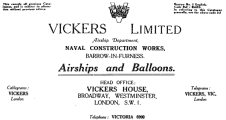
| Company logo & title, a "paste up" of the top, middle and bottom of the page.
VICK_00.GIF |
 | Vickers "V" and Crown logo (300 DPI only) |
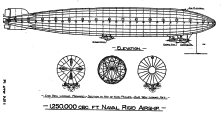
| Plate 1 - Rigid Naval airship
VICK_01.GIF |
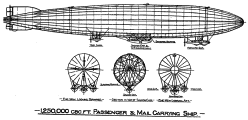
| Plate 2 - 1,250,000 cbc. ft. commercial airship
VICK_02.GIF |
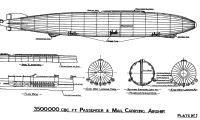
| Plate 3 - 3,500,000 cbc. ft. commercial airship
VICK_03.GIF |

| Plate 4 - 100,000 cbc. ft. sea scout
VICK_04.GIF |
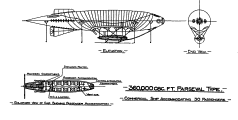
| Plate 5 - 360,000 cbc. ft "Parseval" type
VICK_05.GIF |
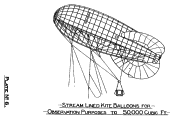
| Plate 6 - Kite balloon
VICK_06.GIF |

| Plate 7 - Spherical balloon
VICK_07.GIF |

| Plate 8 - Aerodrome and mooring tower for rigid airship
VICK_08.GIF |

| Plate 9 - Mooring mast for non-rigid airship
VICK_09.GIF |
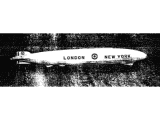
| Model of large commercial airship (as plate 3)
(Scanned from a photocopy of a photograph)
Note: The roundels shown on this model are somewhat puzzling on a civilian airship.
VICK_10.GIF |
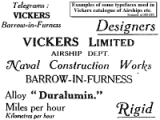
| Examples of the typefaces used in the catalogue.
VICK_11.GIF |
A copy of plate 10 was not available.
Honesty compels me to admit that in the years since the ASCII text version was
scanned to disk I have lost the originals; while I have tried to recall the typography etc.
as best I can for this HTML version, it is possible that some aspects are wrong.
For various reason the first HTML version of this article was converted from one file format
to another in a way that doubled the spacing of most of the pre-formatted text. This somehow
went unnoticed in previous releases, but has now been corrected.
Recommended reading:
- Commercial Airships by H.B.Pratt, who probably drew the plans in this catalogue.
- The British Rigid Airship by Dr.Robin Higham.
- Slide Rule by Nevil Shute Norway













